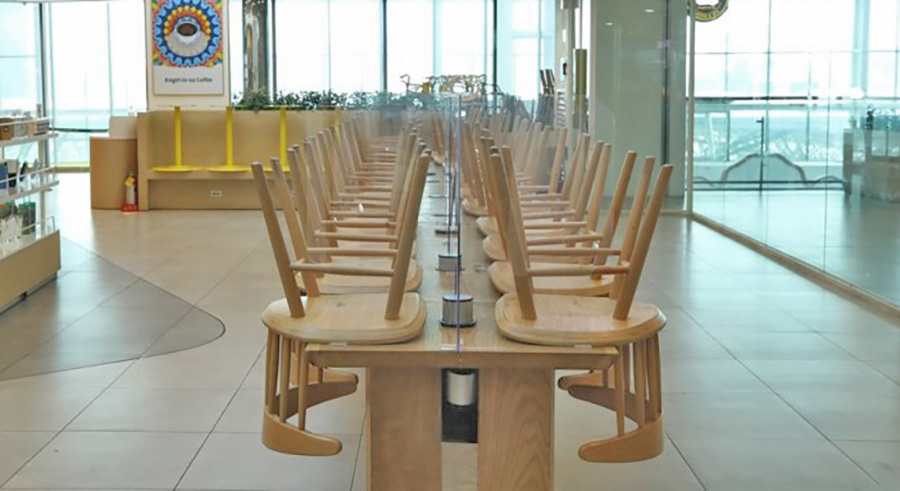The Seoul metropolitan area will move on to physical distancing measures of reduced intensity for the next two weeks, following 14 days of a stricter scheme, the government said Sunday. Prime Minister Chung Sye-kyun, who leads the government’s COVID-19 task force, said that relaxed physical distancing rules would be put in place for Seoul and the nearby regions of Incheon and Gyeonggi Province for a two-week period.
Chung warned, however, that the progress in controlling the virus with intensive distancing may be undone after a long break starting the last day of September for the Chuseok holiday. “For two weeks beginning Sept. 29, special disease control efforts will be undertaken nationwide,” he said.
With the mellower protocols, dining in is once again permitted at coffee chains and other food outlets past 9 p.m. Businesses such as gyms, private tutoring services and computer game rooms that have been completely shut down can resume operations again under limited conditions.
Minors are not allowed at gaming venues to avoid spread in schools. Customers cannot be seated at adjacent tables at coffee chains. All visitors are still required to provide contact details at restaurants.
The ban on in-person services and events at churches, which have been cited as coronavirus hotspots, remains intact until further notice. The announcement comes as Korea confirms 121 more COVID-19 cases — 99 locally transmitted and 22 imported — in the 24-hour period ending Saturday at midnight. The cumulative number of official cases is now 22,175.
The Greater Seoul, which includes Incheon and Gyeonggi Province, accounted for most of the newly registered local cases at 60. The capital region, which has confirmed a total of 9,397, now has more cases than Daegu and North Gyeongsang Province combined — the two areas that were once the epicenter of the epidemic here.
While the numbers have improved from the Aug. 27 peak of 441 to below 200 for the past 11 days, Korea has not met the benchmarks necessary to fall to a less restrictive tier of physical distancing.
Minister of Health and Welfare Park Neung-hoo said in a coronavirus briefing Sunday afternoon that the compromise was made in order to “soften the blow to small businesses.” “Many businesses, especially small businesses, are hurting from the COVID-19 interventions,” he said.
Park added that to contain the transmission, “everyone should limit social contact as much as possible.” Wearing face masks is still mandatory in enclosed spaces and maintaining a distance of 1.5 meters between persons is “strongly advised.”
Korea set out a 3-tiered framework that determines the intensity and timing of physical distancing restrictions based on key metrics such as case growth. In order to move into the softened tier, the daily case count has to stay below 100 for a sustained period of time. Faced with economic challenges, Korea settled short of the most restrictive tier on Aug. 30, despite counting unprecedented numbers in the capital.
The guidance under the adjusted tier — which was set to last until Sunday — entailed a ban on dine-in services at food outlets after 9 p.m. and the closure of risky places such as gyms and nightclubs. Indoor gatherings of over 50 people anywhere were restricted as well. Ahead of the weekend, the government said it would wait until the last minute to decide on whether to keep or ease the physical distancing rules.
The prime minister said Friday the government would “monitor the coronavirus situation for a couple of more days before making the final call.” Yoon Tae-ho, a senior health official, said in a briefing held the same day that the government may come up with “a third way” to cope with a flare-up in infections.
Meanwhile, the surge in seriously ill patients continues to strain the health care systems. As of Saturday, 486 out of 531 critical care beds in the country were occupied, leaving only 45 available. Considering the large proportion of older patients aged above 60 among newly confirmed cases, the demand for critical care beds is expected to increase further.
Contact tracing has also failed to identify a route of infection for 23.4 percent of the patients diagnosed in the last two weeks. The percentage of “untraceable” cases has remained between 20 to 25 percent since August, which is much higher than the government goal of 5 percent or lower.
The number of people in Korea who have died from COVID-19 increased Sunday by three to 358, with the overall death rate recording 1.61 percent. The infection is much deadlier for the elderly, killing nearly 1 in 5 patients aged 80 or older.
The number of recoveries reached 18,226, up 197 from the day prior. There are 3,592 patients currently in isolation for treatment at either hospitals or nonhospital facilities depending on their severity of symptoms. Korea has carried out 2,143,270 tests since Jan. 3. This translates to 41,797 tests performed per million people. The rates of positivity in testing stand at around 1 percent.
Source: The Korea Herald
